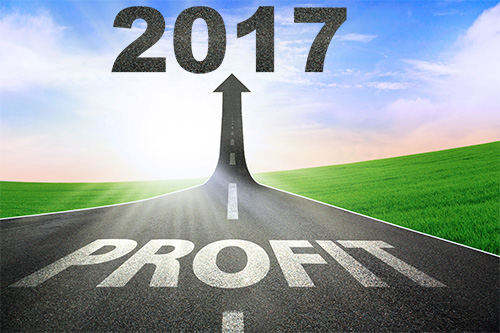
Instead of making a New Year resolution, think of a word to define the year ahead. Common answers are “efficiency,” “growth,” “caution,” or maybe “cash flow” (OK, two words). One we like a lot is “profit.” It’s one word that ultimately proves the financial success of every business.
Profit doesn’t have to be only about the work. Personal profit may involve reaching a goal, such as passing the business on to the next generation or spending more time with family. The following questions address how business owners and managers can assess the status and grow financial profit in 2017.
Question 1: What worked in 2016?
If business was great in 2016, then many companies choose to simply update goals and budgets to take care of a 2017 plan. However, regardless of business conditions, answering the following questions provides valuable direction:
- Did the company embrace any new systems or apps that saved time and money? If not, is this something to consider?
- Which new hires made the strongest impact? Are there positions that need review?
- Was there a marketing campaign that really worked? If yes, what made it successful? If not, are there revisions/updates that will provide a better return on investment?
- Were there any worthwhile events/trade shows that generated ideas or helpful business contacts?
- Did the company add or remove products and/or services? What was the effect on profitability?
- Are there market factors at play that indicate significant growth (or decline) for specific products or services in the coming year?
- Did the company purchase new equipment or open a new location? What is the return on the investment?
- What is the state of product/service pricing? Is there a need to make adjustments?
Finally, summarize the three best things that happened in 2016 and think about how to repeat or revise them to benefit 2017.
Question 2: What didn’t work in 2016?
Without dwelling too much on the negative, list three things that waste time, money or cause stress and decide how to make changes for 2017. Refer to the list of what worked for a primer on what questions to ask.
Question 3: What is the vision for the business in 2017?
At the end of 2017, what will happen for the business to have a successful year? Think in terms of metrics as well as intangibles, such as peace of mind and happiness. Also, consider 2017 part of a longer-term plan. For example, if a 2020 goal is to have revenues of X and profit of Y, what must happen this year to hit that target? Planning the next 3-4 years out greatly increases the likelihood of meeting the lofty, long-term goal.
Your 2017 Profit Plan
Documenting a profit plan is one way to track progress throughout 2017. Start by defining the profit goal ($), then work backward to determine the revenue it will take to reach the goal. Then, add expenses to complete the plan.
Here’s an example:
The goal is to generate 10% profit on $1.5 million in sales, or $150,000.
Start by creating a revenue plan that projects how many items and/or services it takes to reach the revenue target, like this:
|
No. of units |
Price |
Revenue |
|
| Product A |
3,000 |
$200 |
$600,000 |
| Part B |
100 |
$2,000 |
$200,000 |
| Service C |
700 |
$1,000 |
$700,000 |
|
Total |
$1,500,000 |
After projecting the revenue plan, fill in your estimated expenses to see if the profit plan is reasonable. Calculating the expenses associated with the revenue reveals the profitability of the product or service. Knowing the profitability of each product or service provides insight that directs focus for marketing and sales. In many companies, this profit plan is an integral part of the budgeting process.
Profit Decisions
Setting goals and planning ahead for profits keeps a business focused on its financial health and future. A steady stream of consistent, growing profits not only provides an opportunity to reinvest, reduce dependency on debt, or generate a nice life style for the owner, but also maximizes the value of the underlying business for a future sale.
Here’s to a very happy and prosperous 2017!



